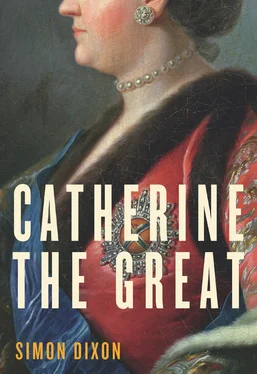So great was the number of coaches—125 all told—and so deep the ranks of the cheering populace, that it took almost two hours for the procession to lumber barely half a mile down the Great Perspective Road to the wooden church of the Nativity of the Mother of God. Designed by Mikhail Zemtsov and known as the Kazan Church because it housed a miracle-working icon of the Virgin of Kazan, closely associated with Petrine triumphs, the church had its bells decorated with the imperial monogram as a symbol of the sacralisation of tsarist power. Its main function following its consecration in June 1737 had been to hold thanksgiving services to commemorate Russia’s ever-lengthening list of military and naval ‘victory days’. 97Now Santi had decreed that ‘for the prevention of confusion and overcrowding’, all doors were to be guarded by sentries with strict instructions to admit no one without a ticket. While Rastrelli had arranged seating in the body of the church for the empire’s highest-ranking officials and the foreign ambassadors, other senior men and their families found places upstairs, though their numbers were limited in advance to prevent the choir loft from collapsing. Only the ‘common people’ were explicitly refused admission. 98
At the end of the opening liturgy, the archbishop of Novgorod emerged from the sanctuary to request the empress’s permission to conduct the marriage. As Elizabeth led the couple to their places on a dais facing the altar, two more prelates emerged bearing the wedding crowns that according to Orthodox tradition were held over the heads of the bride and groom throughout the blessing (Peter’s crown was held by Prince Adolf Friedrich while Aleksey Razumovsky performed the same service for his bride). According to Catherine, who missed no opportunity to highlight the superstitions that penetrated to the apex of Russian society, one of the Court ladies whispered to Peter not to turn round, ‘because the one who turns first will be the first to die’. Whether he really told her to ‘clear off’ cannot be known (it is possible, but it sounds very much like one of Catherine’s attempts to besmirch his memory). After the rings had been exchanged, the couple turned to prostrate themselves before the empress, who lifted them to their feet and embraced them as they listened to Simon (Todorsky), now bishop of Pskov, preach a sermon praising Providence for uniting these two offspring of the houses of Anhalt and Holstein. 99By four in the afternoon, they were all back at the Winter Palace for a banquet. Catherine sat to Elizabeth’s left, next to her uncle, Prince Adolf Friedrich. Behind her, in attendance, stood Count Peter Sheremetev; Count Andrey Hendrikov served as her ‘carver’ for the meal. When the tables were cleared, she was so exhausted by the weight of her crown that she longed to remove it. But since that gave rise to another superstitious worry on the part of her ladies, she was permitted to do so only after anxious consultations with the reluctant empress. 100
The most theatrical celebration of all came on the following evening. That morning, after Peter had been formally congratulated by the ambassadors and leading statesmen, the Court transferred to the Summer Palace for lunch. While Her Majesty sat on her usual chair, upholstered in emerald green, Their Imperial Highnesses (as Catherine and Peter were to be called for the remainder of Elizabeth’s reign) were given trademark red ones embroidered in gold. Catherine was placed opposite her husband, between Elizabeth and Aleksey Razumovsky, who had an exultant Armand Lestocq on his other side. In their absence, the Winter Palace was made ready for a ball that went on until midnight, when the Marshal of the Court led the procession to dinner. While Elizabeth dined with the clergy and her intimates in a neighbouring stateroom, Peter and Catherine presided over a meal for 130 guests in a banqueting hall transformed for the occasion by Rastrelli. 101Let the architect describe his own fantastic creation:
Between the first two ledges of the tables another ledge was made, covered with turf, on which were arranged fifty pyramids with Italian flowers in earthenware pots, decorated with gilded carvings with festoons of the same flowers, and between them burned two rows of crystal lamps with candles made from the purest white wax. At the corners of the second table were eight fountains in the form of mushrooms, each three funts in diameter. To the side of each fountain stood two marble statues, three funts high. The whole of the large upper ledge was covered with glass pyramids burning with candles of various sorts, so that everything around the cascades and the pedestals of the statues was illuminated by some eight thousand flames. With the music that played throughout and the noise of the water flowing through the fountains, it all made for a magnificent spectacle. 102
Since it was nearly two in the morning by the time fountains and orchestra ceased playing, the Court required a day of rest before the festivities could resume. Among the most colourful events still to come was a ball on 26 August. While lottery tickets were sold at 2 roubles each (there were 15,000 losing numbers and 2,000 winning ones), the guests formed into four quadrilles, each comprising seventeen pairs. Catherine’s set was dressed in white and gold, Peter’s in rose and silver, Johanna Elisabeth’s in light blue and silver, and the last, led by Adolf Friedrich, in yellow and silver. Disconcerted to find that each quadrille had been ordered to stick to its allotted corner of the ballroom, a tearful grand duchess persuaded the Hofmarshal to allow them to mingle, since otherwise she would have been obliged to dance with courtiers as ‘lame, gouty and decrepit’ as her partner, Field Marshal Lacy. If it was an obvious exaggeration to claim that men such as Peter Shuvalov (b. 1710) were aged ‘between sixty and eighty’, he and the other senior members of her quadrille, who included Prince Nikita Trubetskoy and Count Mikhail Vorontsov, were no match for a fun-loving princess who had spent most of her first year in Russia playing riotous games with girls of her own age. ‘I never saw a more doleful or insipid entertainment,’ she recalled in 1791. 103
Francesco Araja’s new opera, Scipio , which they had all attended the night before, must have run it close. Handel’s version of Scipio’s capture of New Carthage, drawn from the Roman historian Livy, had been premiered in London as long ago as 1726. But since his plot of a general exercising his rights of conquest over a beautiful female captive was scarcely appropriate for Catherine’s wedding, Araja’s librettist, the mediocre Florentine poet, Giuseppe Bonecchi, told a more conventional love story enhanced by his ballet intermezzo ‘Cupid and Psyche’. Even if the audience was reassured by the announcement in the extravagantly bound programme that the performance would be ‘at least a third shorter than last year’s’, they do not seem to have enjoyed it much. Though they dutifully sang a hymn in praise of the empress when it finished at half past ten, Scipio was reprised only once at Court. 104
More immediately successful was the firework display on 30 August, the tenth and final day of the celebrations, preserved for posterity in an engraving by Grigory Kalachov. Stretching out behind a flaming obelisk bearing the emblems of the married couple, Elizabeth, and her father, Peter the Great, was a vast colonnade that catered to the empress’s anxieties about dynastic legitimacy by sheltering statues not only of Peter and his second wife, Catherine I, but also of his father, Tsar Aleksey Mikhailovich, and Tsar Mikhail Fëdorovich, the founder of the Romanov dynasty in 1613. The whole scene was set on a huge raft on the Neva, surrounded by tritons and all manner of fantastic sea creatures. In the foreground sat Neptune in a chariot drawn by sea horses, next to Venus, the goddess of love, who held two flaming hearts in her hands with two kissing doves behind her as a symbol of conjugal bliss. 105
Читать дальше












